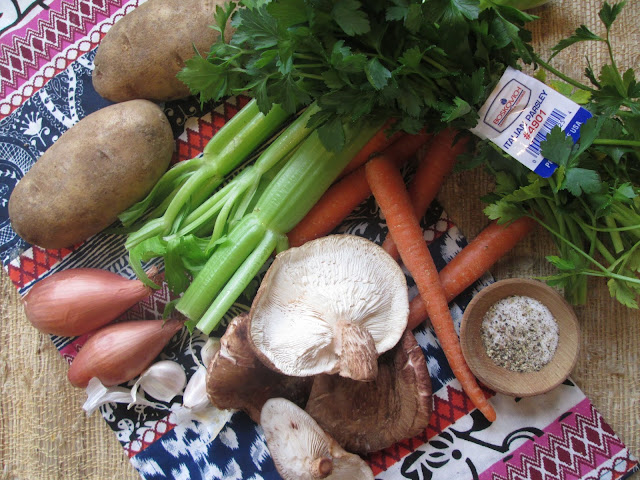The Zero Food Waste movement has been going strong for a while, but it's something that I've always practiced in my kitchen. I absolutely CANNOT STAND to watch anyone throw food away, let alone do it myself.
I have a couple tricks up my sleeve when it comes to using what I have. Quite often I have veggies and/or fruits that start to languish. When this happens I mostly cut them up, if need be, and freeze them for later. Other times, if I have enough veggies going off at the same time, I'll make vegetable stock.
Today I gathered up some leftover veggies that have been looming around, plus some shitake mushrooms I bought at the farmers market yesterday. I don't care for the texture of mushrooms, but I am crazy about their savory earthy flavor and they make a wonderful addition to any stock.
I followed Mark Bittman's recipe, but as you can see below, there are endless combinations to choose from. Clean out your veggie bin and use what you have. That's the number one goal: zero waste.
I recommend making veggie stock to everyone I know because it is the best way to use up what you have. Simply throw it all in a large stockpot, add enough water to cover, and set to simmer. Walk away. It's one of the easiest things you'll ever make.
Now, a good question my friends ask is, "what do I do with the veggie stock?" Well, personally, I like to warm mine up in a mug and drink it. It's warm and cozy and full of vitamins, minerals, and nutrients. Another huge go-to for me is a hearty and comforting lentil soup, but any veggie-based soup would be a wonderful way to use your stock. I also like to keep some stock around to deglaze a pan when needed. However, once you make it, you will find many uses for it!
Quick Vegetable Stock
Adapted From The Food Matters Cookbook
by Mark Bittman
Makes about 2 quarts
4 carrots, cut into chunks
2 medium or 1 large onion, unpeeled and quartered*
2 potatoes, scrubbed and skins left on, cut into chunks
3 celery stalks, roughly chopped (leaves included)
3 or 4 garlic cloves
20 or so stems parsley, with or without leaves
salt and black pepper, to taste
Optional add-ins: dried or fresh mushrooms; fresh, or canned, tomatoes; root vegetables such as parsnips or turnips; winter squash; fresh herbs; leeks; lemon zest; cloves or other warm spices; gingerroot. Avoid bell peppers or eggplant, which are too bitter. If you use cabbage, cauliflower, or broccoli, their flavors will dominate.
Make sure all your produce is clean. Combine everything in a stockpot with 3 quarts water and salt and pepper, to taste. Bring to a boil and adjust the heat so the mixture bubbles steadily but gently. Cook until the vegetables are tender, about 30 minutes (cooking longer will improve the flavor, but a few minutes less won't hurt much either). I cooked mine about 45 minutes, tasting and seasoning occasionally to see if the flavors were where I wanted them to be.
Strain, then taste and adjust seasoning before using. Cool before refrigerating or freezing.





I wish more authors of this type of content would take the time you did to research and write so well. I am very impressed with your vision and insight. SEO
ReplyDeleteSo amazing! I've been meaning to do this and really should just start to make it a weekly practice.
ReplyDelete